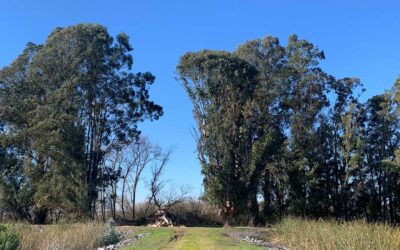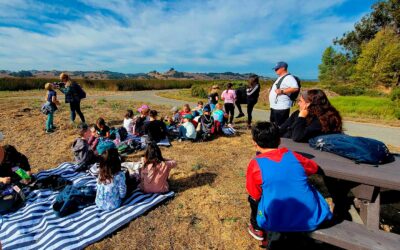The sounds of spring
Recordings of bird calls reveal hidden details about shifting state of native ecosystems
By STEPHEN NETT
FOR THE PRESS DEMOCRAT
The drought has officially broken, the signs are everywhere. Lush grass carpets the hillsides, oaks are leafing out, creeks and streams run high. But what about the native wildlife? It’s 5:34 a.m., an hour before dawn, and in the Mayacamas mountains above the Valley of the Moon it’s still too dark to see the rocks on the trail. Jacketed against the chill, my three companions are talking quietly as we wait without lights for the sun to rise.
The reason we’re standing in the dark 1,300 feet up in the mountains next to burbling Sonoma Creek is because we’re with Bernie Krause, a globe-trotting Glen Ellen audio specialist who has a passion for capturing the secret sounds of animal life. We’re hoping to hear something special: the dawn chorus, the waking cacophony of wild birds on a spring morning in Sugarloaf State Park after a wet season of much-needed rain.
Krause, a musician turned soundscape ecologist, has been setting up his precision microphone and digital equipment to record the birds on this spot since 1994.
Today, we’re not sure what we’ll hear. The past five years, as the drought tightened its grip, Krause’s recordings have documented the once rich symphony of birds here growing weaker and dimmer, nearly fading away. Last week with a national TV news crew, Krause’s sensitive microphone captured the distant rumble of high flying jetliners, but little else.
As the gray sky lightens, a single bird in a tree to our right rings out a pattern, then falls quiet. “We should be hearing many birds by now,” Krause says. We listen as distantly as we can for any sign of them. The shushing creek passes by, headed downstream. Dawn approaches in silence. Then, a clear bright song erupts, and is answered, across the creek, by a welcome reply.
Later, Krause’s recorder replays a modest chorus singing from the coyote bush thicket downstream, where the microphone was sited. It’s a tiny, cheerful display of interacting birds, but nothing like the rich tapestry of songbirds that was here before the drought.
Morning singers
The dawn chorus — a rousing flurry of calls and songs as songbirds greet first light — can be disturbing outside your window if you’re trying to get a few extra minutes of sleep. But in nature, it’s a good way to measure how the millions of birds living among us are managing in the modern world.
No one is exactly sure why birds perform the dawn chorus. People who study avian behavior think it has to do with the birds announcing their presence, claiming territory, and attracting mates in the quiet of dawn, before they leave their roosts to forage for food.
Which makes sense. If you’re a bird, hidden from sight in a shrub or tree, the quickest way to contact, find, and be recognized by the other birds spread out around you is with sound. And birds have evolved an incredible array of vocalizations for just that purpose, as well as special gear for the task.
Vocalization
Unlike the human voice box, or larynx, songbirds have two sound making organs, joined in an upside-down Y shape, just above their lungs, called the syrinx. With fine control, they’re able to manipulate both sides of the syrinx independently. This lets them sing two notes at once, even one with rising pitch while the other is falling, and at different speeds and frequencies. That’s how they can produce such an incredible range of twits, squeals, ringing tones and soaring, complex songs.
To Krause, those sounds are part of a living soundscape, a biophony, and he’s one of the first in the world to seriously study how the audible part of an ecology reveals the life in that environment. Rather than pointing a microphone at a single bird to record its song, he listens to the entire landscape, and how the sounds within it interact. He’s recorded insect larvae in streams, anemones in tide pools, and birds around the world.
With the computer in his office, he creates spectral graphs on a screen, and teases out the different layers of sounds the various creatures make. Krause points to a crucial feature: the unique sound each creature makes occupies a space, a niche, that lets it be heard amongst all the others, and the general din.
He has a lot of subjects to work with here. In the latest count, Sonoma County had more resident birds than any of the surrounding nine counties, 179 different species, and nearly that many more wing through here on migrations north and south. A growing number of bird enthusiasts and naturalists now specialize in listening to them — birding-byear, as the practice is known.
That’s possible because each of those individual bird species has its own unique song patterns, Daniel Edelstein explains. Edelstein, a Marin-based freelance professional birding guide and consulting avian biologist, has been leading birding outings for more than 30 years, and teaches “The Ecology of Birds’ Songs and Identifying Them By Ear” at Merritt College in Oakland, leading students to prime spots around the Bay Area and Sonoma County.
“Most songbirds learn their songs from mentors living around them,” he says. The vocalizations are learned and memorized over the initial year of the bird’s life. Remarkably, birds of the same species who live in different regions can develop local dialects. “The white crowned sparrow can recognize others of its own species, as well as other bird species,” Edelstein notes. “The only songbirds in Sonoma County who do not learn their vocalizations are flycatchers, who are born with the ability.”
Birding-by-ear
Chris Engel is one of those who enjoys the challenge of birding-byear. She’s been an active volunteer with the Sonoma Land Trust and a docent for their Glen Oaks Ranch property, and first got involved with birding in 2007. Birding doesn’t always involve having to “find” the bird, she says. There’s also great satisfaction in just appreciating and experiencing the songs and calls that surround you. Birds vocalize all day long, not just at dawn, of course, and there’s a softer sunset chorus as well.
While Engel was fortunate to learn with expert birders like the legendary Rich Stallcup, she notes there are apps today that can help identify bird songs and calls, like iBird, Cornell Labs, and Sibley.
But she cautions against using apps to attract birds by playing their calls. It’s not just bad form, Engel notes, it’s bad for the birds. They may be pulled away from nests, exposed to predators, or distracted from feeding. Surviving in nature is already hard enough without the extra stress from humans.
Unfortunately, human noise has a big impact on the ability of birds to hear each other and communicate, says Tom Rusert, an avid Sonoma ornithologist and conservationist. Rusert and Darren Peterie, co-founders of Sonoma Birding-Sonoma Nature, a nonprofit based in Sonoma, were awarded the John Muir Conservationists of the Year award in 2014.
Urbane and passionate, Rusert is at ease in Wellington boots, required gear for this year’s wet marshes and abundant ticks. He leads citizen science events locally and has been involved for years in local Christmas bird
counts, and created a nationwide birding program for kids.
“Birds can tell you a lot about an environment, and whether it’s healthy or not”, he says. Because birds are often hidden from sight, sound may be the best, or the only way to find them.
Nesting season
It was a saving factor during nesting season last spring, when Rusert intervened to stop chainsaws removing limbs from giant eucalyptus trees in Sonoma’s Depot Park. The city’s biologist had seen no sign of nesting birds before giving the go ahead, but Rusert and other birders were aware that great horned owls and acorn woodpeckers were raising young in the trees, because they could be heard chorusing at twilight. Most of the nests were saved.
Nesting birds are protected by federal law nationwide.
The spring nesting season is also the busiest time for Veronica Bowers, director of Native Songbird Care & Conservation, a federal and state licensed wildlife hospital in Sebastopol specifically for songbirds. The majority of their patients come in between April and August, including hatchlings as young as 24 hours old.
Learning to sing
Three-quarters of the birds they care for are rehabilitated, Bowers says, and returned to the wild. But since they’re raised apart from their own kind, the young birds have no way to learn the songs and calls they need to communicate.
To teach them their song, volunteers go out and record mentor birds in locations near the place the birds were found. “Songbirds usually learn from an adult male, so we record the dawn chorus and play it back twice a day,” Bowers explains.
But it’s not always simple. Even Sonoma County birds have regional dialects. An east side sparrow and a coastal sparrow can have different songs, and getting them wrong can leave the birds helpless. “For the birds,” she says “it’s like showing up in Hawaii, and being the only one speaking French.”
Because birds live in communities, have families, neighbors, and enemies, communication is essential, Bowers says. When people take a bit of time and eavesdrop on birds interacting, it can be a revealing experience, whether on 4th Street or a trail in the mountains.
For Krause, soundscapes of birds in their habitat tell a great deal more than meets the eye. The microphone can detect their density and behaviors, and especially, the health of an environment. Human impacts and environmental changes, like the recent drought, can have unseen and dire consequences.
Krause likens studying ecology without sound to watching Star Wars without the soundtrack. You miss a lot. To understand what’s happening at ground level, in the understory, and high in the treetops, there are facts that only sound can reveal.
It’s not yet clear what the faint dawn chorus in the Mayacamas Mountains means about the birds there, and whether the changes are permanent. But as long as he’s able, Krause will be listening. Stephen Nett is a Bodega Bay-based Certified California Naturalist, writer and speaker. Contact him at snett@californiasparks.com.
Copyright © 2017 PressDemocrat.com All rights reserved. Restricted use only. 4/20/2017






0 Comments